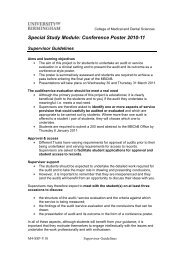Contents - College of Medical and Dental Sciences - University of ...
Contents - College of Medical and Dental Sciences - University of ...
Contents - College of Medical and Dental Sciences - University of ...
Create successful ePaper yourself
Turn your PDF publications into a flip-book with our unique Google optimized e-Paper software.
The 11 th International Workshop on KSHV & Related Agents, Birmingham, UK<br />
Latency Abstract 2<br />
DIVERGENCE OF THE NUCLEAR LOCALIZATION SIGNAL WITHIN THE ORF73<br />
LATENCY-ASSOCIATED NUCLEAR ANTIGENS (LANA) OF KSHV AND THE<br />
MACAQUE RV1 AND RV2 RHADINOVIRUSES<br />
Kellie L. Burnside 1 <strong>and</strong> Timothy M. Rose 1,2<br />
1 Seattle Children’s Hospital Research Institute <strong>and</strong> 2 <strong>University</strong> <strong>of</strong> Washington, Seattle WA<br />
Abstract<br />
KSHV LANA is targeted to the nucleus <strong>of</strong> infected cells by a discrete lysine/arginine-rich<br />
nuclear localization signal (NLS; Region I), which allows LANA to enter the nucleus <strong>and</strong><br />
mediate viral episome persistence, interact with cellular proteins <strong>and</strong> play a role in<br />
latency <strong>and</strong> tumorigenesis. Conserved homologs <strong>of</strong> LANA that also exhibit nuclear<br />
localization have been identified in KSHV-like macaque herpesviruses belonging to the<br />
RV1 <strong>and</strong> RV2 lineages <strong>of</strong> Old World primate rhadinoviruses. To characterize the signals<br />
mediating nuclear localization, the N-terminal domains <strong>of</strong> the LANA homologs <strong>of</strong> the<br />
macaque RV1 (RFHVMn) <strong>and</strong> RV2 (RRV <strong>and</strong> MneRV2) rhadinoviruses were structurally<br />
<strong>and</strong> functionally compared to the KSHV NLS. A distinct lysine/arginine-rich NLS motif<br />
was identified in RFHVMn LANA (Region II) that was adjacent but evolutionarily unrelated<br />
to the KSHV NLS. An extended glycine/arginine-rich NLS, spanning 46 residues across<br />
Regions I <strong>and</strong> II, was identified within the RRV <strong>and</strong> MneRV2 LANAs. Although<br />
evolutionarily distinct, the NLS motifs <strong>of</strong> the human <strong>and</strong> macaque RV1 rhadinoviruses,<br />
KSHV <strong>and</strong> RFHVMn, both conform to the consensus motif for classical NLSs which interact<br />
with importin alpha during nuclear localization. In contrast, the NLSs <strong>of</strong> the more<br />
distantly-related macaque RV2 rhadinoviruses conform to the structure <strong>of</strong> a number <strong>of</strong><br />
glycine/arginine-rich NLS motifs which bind directly to importin B during nuclear<br />
transport. Like other proteins containing glycine/arginine-rich NLSs, the RV2 LANAs are<br />
targeted to the nucleolus. Our findings suggest that the LANA homologs <strong>of</strong> the RV1 <strong>and</strong><br />
RV2 rhadinoviruses may be differentially transported <strong>and</strong> function in different subnuclear<br />
compartments.<br />
Presenting author Email: timothy.rose@seattlechildrens.org<br />
22















